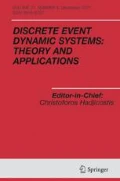Abstract
In this paper, we widen the class of P-time Event graphs by introducing affine-interdependent residence durations. This new class is studied through a general algebraic model. Considering a periodic behavior, we provide conditions of existence of a trajectory and propose a technique allowing the determination of extremal solutions. We show that the cycle time is intrinsic to this new model: it depends on the circuits of an associated graph but also on more complex structures.




Similar content being viewed by others
References
Baccelli F, Cohen G, Olsder GJ, Quadrat J-P (1992) Synchronization and linearity. An algebra for discrete event systems. Wiley, New York. Available from: http://maxplus.org
Burns SM (1991) Performance analysis and optimization of asychronous circuits. Ph.D., Institute of Technology, Pasadena, California, USA
David R, Alla H (1992) Petri nets and Grafcet, tools for modelling discrete event systems. Editions Prentice Hall, Londres
Campos J, Chiola G, Colom JM, Silva M (1992) Properties and performance bounds for timed marked graphs. IEEE Trans Circuits Syst 39(5):386–401
Declerck P, Guezzi A, Boimond J-L (2007) Cycle time of P-time Event Graphs. In: 4th international conference on informatics in control, automation and robotics (ICINCO 2007), 09–12 May. Angers, France. Avalaible from: http://www.istia.univ-angers.fr/~declerck/recherche.html
Declerck P, Guezzi A, Gros C (2008) Temps de cycle des Graphes d’Événements Temporisés et P-temporels. In: CIFA 08. Bucharest, Romania. Avalaible from: http://www.istia.univ-angers.fr/~declerck/recherche.html
Declerck P (2011) From extremal trajectories to consistency in P-time Event Graphs. IETAA9, IEEE Trans Autom Control 56(2):463–467. Available from: http://www.istia.univ-angers.fr/~declerck
Declerck P (2013) Discrete event systems in dioid algebra and conventionnal algebra. Focus Series in Automation & Control, ISTE Ltd and John Wiley & Sons Inc., New York
Defossez F, Collart-Dutilleul S, Bon P (2008) Temporal requirements checking in a safety analysis of railway systems. In: FORMS/FORMAT 2008, Symposium on formal methods for automation and safety in railway and automotive systems. TU Braunschweig and Budapest University of Technology and Economics
Giua A, Piccaluga A, Seatzu C (2000) Optimal token allocation in timed cyclic Event-Graphs. In: Proc. 4th workshop on discrete event systems, pp 209–218
Karp RM (1978) A characterization of the minimum mean-cycle in a digraph. Discret Math 3:309–311
Khansa W (1997) Réseaux de Petri P-temporels. Contribution à l’étude des systèmes à Evénements discrets. Thèse. Université de Savoie, France
Magott J (1984) Performance evaluation of concurrent systems using Petri nets. Inf Process Lett 18:7–13. North-Holland
MuDer Jeng (2005) Comments on timed Petri nets in modeling and analysis of cluster tools. IEEE Trans Autom Sci Eng 2(1):92–93
Murata T (1989) Petri nets: properties, analysis and applications. Proc IEEE 77(4):541–580
Ramamoorthy CV, Gary Ho S (1980) Performance evaluation of asynchronous concurrent systems using Petri nets. IEEE Trans Softw Eng SE-6(5):440–449
Savard G (2001) Introduction aux méthodes de points int érieurs, course notes. Avalaible from: http://www.iro.umontreal.ca/~marcotte/Ift6511/Pts_interieurs.pdf
Schrijver A (1987) Theory of linear and integer programming. John Wiley and Sons, New York
Silva M, Colom JM (1989) On the computation of structural synchronic invariants in P/T nets advances in Petri nets. In: Rozenberg G (ed) pp 386–417. Springer-Verlag, New York
Author information
Authors and Affiliations
Corresponding author
Appendix
Appendix
Let us express system inequalities (1) on a reduced horizon. Such a form will simplify the calculations. The objective is to establish an equivalent model such that each place of the graph initially contains only zero or one token.
Roughly speaking, the general idea is to split each place containing i tokens into i places, where each place contains only one token (a place can initially contain a maximum number of m tokens). A systematic procedure is as follows.
Let us introduce new variable X, that is, \(X(k)=(X_{0}^{t}(k) \; X_{1}^{t}(k) \; \ldots \; X_{i}^{t}(k) \; \ldots X_{m-1}^{t}(k)) ^{t}\) with X i (k) = x(k − m + i + 1). By construction, we have X m − 1(k) = x(k) and X i (k) = X i + 1(k − 1) for i going from 0 to m − 2.
So, system (1) becomes
where \(G_{1}^{^{\prime }-}=( G_{m}^{-} \; 0 \; \ldots \; \ldots \; 0 )\), \(G_{0}^{^{\prime }-}=( G_{m-1}^{-} \; G_{m-2}^{-} \; \ldots \; G_{1}^{-} \; G_{0}^{-} )\), \(G_{1}^{^{\prime }+}=( G_{m}^{+} \; 0 \; \ldots \; \ldots \; 0 t)\) and \(G_{0}^{^{\prime }+}=( G_{m-1}^{+} \; G_{m-2}^{+} \; \ldots \; G_{1}^{+} \; G_{0}^{+} )\).
This system is completed by X i (k) = X i + 1(k − 1) for i going from 0 to m − 2 which is equivalent to the following inequalities
for i = 0 to m − 2. The relevant matrix form is as follows:
where the dimension of the matrices \(H_{01}^{-}=-H_{01}^{+}\) and \( H_{00}^{-}=-H_{00}^{+}\) is ((m − 1).|TR|×m.|TR|). The matrix \( H_{01}^{-}\) is a subdiagonal of identity matrices immediately above the main diagonal and the matrix \(H_{00}^{-}\) is a main diagonal of negative identity matrices.
Finally, the concatenation of the two systems gives the algebraic form
where \( G^{-}=\left( \begin{array}{rr} G_{1}^{^{\prime }-} & G_{0}^{^{\prime }-} \\ H_{01}^{-} & H_{00}^{-} \end{array} \right) \) and \( G^{+}=\left( \begin{array}{rr} G_{1}^{^{\prime }+} & G_{0}^{^{\prime }+} \\ H_{01}^{+} & H_{00}^{+} \end{array} \right) \).
Rights and permissions
About this article
Cite this article
Declerck, P. Cycle time of a P-time Event Graph with affine-interdependent residence durations. Discrete Event Dyn Syst 24, 523–540 (2014). https://doi.org/10.1007/s10626-013-0173-3
Received:
Accepted:
Published:
Issue Date:
DOI: https://doi.org/10.1007/s10626-013-0173-3



